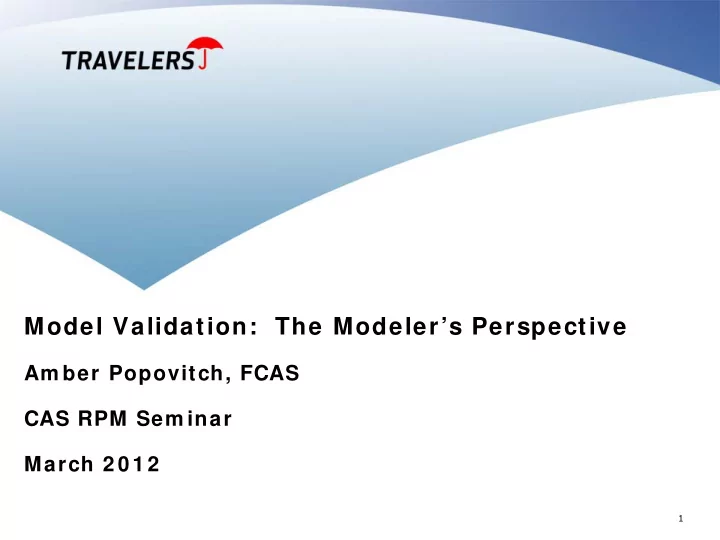

Model Validation: The Modeler’s Perspective Am ber Popovitch, FCAS CAS RPM Sem inar March 2 0 1 2 1
Disclaim er The views expressed in this presentation are those of the author and do not necessarily reflect the views of The Travelers Companies, Inc. or any of its subsidiaries. This presentation is for general informational purposes only. 2
W hat I s Model Validation? From a modeler’s perspective, there are two parts: • Model Building –Have I chosen the right model? (e.g. are assumptions valid?) –Have I selected the right variables? –Have I adhered to the principle of parsimony? –Have I selected the right factors? • Model Testing –Have I achieved the modeling objectives? –Have I avoided over-fitting my data? –Have I created a model that will predict future behavior? 3
Data Partitioning • Training / Validation / Holdout Approach • Out of Time Validation • Bootstrapping Approach Original Bootstrap 1 Bootstrap 2 Bootstrap 3 1 1 3 2 2 1 4 2 3 2 5 3 4 3 5 3 5 3 5 4 • Cross Validation Approach Original CrossValid1 CrossValid2 CrossValid3 CrossValid4 CrossValid5 1 2 1 1 1 1 2 3 3 2 2 2 3 4 4 4 3 3 4 5 5 5 5 4 5 1 2 3 4 5 4
Model Building Tools and Techniques • Type III statistics What happens when model • p-values for variable levels assumptions are violated? • Factor assessment –Does it make business sense? –Does the relationship make sense? (e.g. monotonic) The easy part is coming up with • Comparison with other techniques the story. . . –Univariate analysis Beware of –Decision trees correlations! • Residual analysis • AIC / BIC / log-likelihood / deviance measures 5
Connecting Model Building and Model Testing Optimal Model Complexity Validation Error Training Error * From Elements of Statistical Learning by Hastie, Tibshirani, and Friedman 6
Model Testing Tools and Techniques The Lift Chart Questions: Sample Lift Chart • How should lift be measured? 1.4 • How many buckets? 1.2 • How should reversals be 1 Loss Ratio interpreted? 0.8 Actual Predicted • Are there variable biases affecting 0.6 the ordering? (e.g. size, policy year) 0.4 0.2 • Is there over-fitting? 0 • Fit vs. Lift? 1 2 3 4 5 6 7 8 9 10 Decile 7
Model Testing Tools and Techniques The GI NI I ndex A Gini A B Cum % of Loss • Commonly used to assess income inequality across countries • More granular assessment of model fit • Gives information on model segmentation Cum % of Exposure • -1 ≤ Gini ≤ 1 (1 = more segmentation, better fit) Sort Predictions Low -> High Reference: http://en.wikipedia.org/wiki/Gini_index 8
Model Testing Tools and Techniques Com paring Across Models • Which modeling technique is best? • How much better is this version vs. the last one? • Can use any measure you’d like – lift, GINI index, etc. • Some software packages have this capability built in (e.g. Enterprise Miner) • Be careful of over-fitting • Don’t use this on the holdout data as a model building technique! * from SAS Enterprise Miner documentation 9
Food For Thought. . . Should there be an actuarial standard of practice addressing predictive m odeling? – Topics such a standard might address • When is out-of-time validation rather than just out-of-sample validation critical? • What steps should be taken to ensure knowledge of the holdout data has not crept into the model-building process? – For instance, split off the holdout data before or after EDA? – Splitting it too early makes balancing to control-totals difficult • Auditing – “Lock up” holdout data? – Peer review standards • What should be done when holdout data “disagrees?” 10
Recommend
More recommend